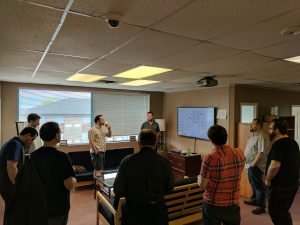Your Engineers Are Drowning (And Your Clients Know It)
Are you watching your best technicians burn out while tickets pile up faster than your team can close them? Is critical knowledge trapped in individual engineers' heads while others struggle with the same issues?
If you're nodding along, you're experiencing what we call the "The MSP Scaling Challenge." Here's what it looks like:
-
Your senior engineer just spent 3 hours fixing a complex Office 365 issue; meanwhile, down the hall, another engineer is starting the exact same troubleshooting process
-
While this duplication happens,many tickets are close to passing their SLA
-
Your team is working harder than ever, yet they're falling further behind each day
-
Engineers feel isolated and frustrated because they're fighting fires alone
-
Clients are starting to complain about response times, and you can't blame them
The real kicker? The solution already exists in your organization. One engineer knows the fix, but the other doesn't know they know. By the time they figure it out, another day of productivity is lost.
This isn't a staffing problem; it's a communication problem, and it's costing you thousands of dollars every week.

The 10-Minute Solution That's Changing MSPs
What if everything could change with just 10 minutes each morning? No complex project management overhaul, no expensive consultants, just a simple daily huddle that becomes a secret weapon.
Here's what MSPs are experiencing with daily huddles:
-
Backlogs that seemed permanent are finally getting eliminated
-
Engineers are closing tickets on the first touch instead of endless back-and-forth
-
Teams are cutting project meeting time by 50% because everyone already knows what's happening
-
Work is actually flowing instead of getting stuck in bottlenecks
-
Engineers report feeling more connected and less overwhelmed
However, the biggest change isn't just in the numbers; teams are actually working like teams, not just collections of individuals fighting fires alone. As one MSP put it: "We're finally on top of things."
From Chaos to "This Changed How We Work"
Picture this common MSP morning: It's 8:47 AM on a Tuesday, you're staring at the ConnectWise dashboard, watching ticket counts climb. Three engineers are out sick, two major clients are having issues, and an SLA breach notification just hit your inbox.
Sound familiar?
Week 1: The Awkward Beginning
The first huddle is typically painful. Engineers stand around a monitor, shuffling their feet, wondering why they aren't at their desks working tickets. The meeting runs too long (often 30-45 minutes) and feels forced; nevertheless, successful teams stick with it.
Week 2: The Breakthrough
Here's a typical week-two scenario: During the morning huddle, Mike mentions he's stuck on a SharePoint permissions issue for a client. Lisa perks up immediately: "Oh, I fixed that yesterday for another client—it's a registry key issue. I'll show you after the huddle."
What would have been a 2-hour research project becomes a 5-minute knowledge transfer.
That's when teams understand; this isn't just another meeting. This is their daily insurance policy against wasted time.
Week 3: The Culture Shift
By week four, something magical typically happens. Engineers start arriving early to prep for the huddle; they're excited to share solutions. The meeting becomes the heartbeat of the service desk.
As one lead engineer described it: "This changed the way we work. We're not just fixing tickets anymore; we're actually helping each other succeed."
Your Exact Blueprint for Huddle Success

After running daily huddles successfully and seeing dozens of MSPs implement them, here's the exact structure that consistently works:
The 10-Minute Huddle Breakdown - MSP Edition
Quick Start (1 minute)
"What tickets are stuck right now?" - Go around the team, rapid-fire style. No deep dives yet, just flag the blocked tickets.
Deep Dive (6 minutes)
Focus only on the critical blockers that surfaced:
-
Which client/ticket is impacted?
-
What's preventing resolution? (vendor response, client approval, missing access, etc.)
-
Who can unblock it? (escalation to vendor, client contact, senior tech)
-
What resources do they need to close it out?
Skip the SLA metrics and ticket counts - save that for weekly reviews.
Action Items (2 minutes)
-
Assign ownership for each blocked ticket
-
Set follow-up times in the PSA
-
Quick confirmation: "Does everyone know their next move on these tickets?"
Close (1 minute)
"Any other fires or escalations brewing?" This is the last chance to flag critical issues before everyone gets back to the queue.
The whole point is getting tickets flowing to resolution, not creating another metrics review. Keep it focused on today's blockers and getting techs unstuck. If someone starts to problem solve and get into the weeds of the ticket, redirect: "Let's take that offline and focus on what's preventing ticket closure right now."
Critical Implementation Details
.png?width=2000&name=image%20(4).png)
Visual Management Is Non-Negotiable Use a large monitor showing your PSA dashboard, display ticket aging, SLA status, and backlog metrics. Make problems visible because you can't fix what you can't see.
Same Time, Every Single Day We used 9:29 AM because odd times are memorable. Remote techs dial in via Teams or Zoom, and consistency builds habits.
Rotate the Quarterback A different person leads each week, which builds leadership skills across the team and keeps energy fresh.
"We Don't Have Time" and Other Myths Costing You Money
Let's be honest about some common objections:
"I'm at a client site... I'm driving" – It's only 10 minutes. You can dial in from anywhere.
"I'm working on my own stuff and not with others" – That's exactly the problem. Working in silos is what's killing your efficiency.
These sound like valid reasons to skip the huddle, and that's the same reaction from most MSPs. However, here's what those excuses are actually costing you.
The Math Doesn't Lie
Let's break down the real numbers:
-
10-minute huddle × 5 engineers = 50 minutes invested daily
-
Average time saved per engineer through better communication = 45 minutes
-
Total time saved = 225 minutes (3.75 hours) daily
-
Net time saved = 175 minutes (2.9 hours) every single day
-
Monthly impact = ~58 hours of additional productivity (based on 20 workdays)
But it gets better. The efficiency gains compound over time:
-
Dramatic reduction in ticket resolution time as engineers share solutions
-
Fewer escalations because issues get resolved at the right level
-
Significant drop in tickets aging past their SLA
-
Less "emergency" firefighting as problems get caught early
One MSP in Dallas put it perfectly: "We made tremendous progress. The huddle helped us eliminate our backlog completely; we're finally working proactively instead of reactively."
The Hidden Benefits No One Talks About
Beyond the metrics, daily huddles create something invaluable:
-
Engineers feel connected and supported rather than isolated
-
Knowledge flows naturally between team members
-
New hires onboard faster by listening to daily huddles
-
Client satisfaction improves because they notice when issues resolve faster
-
Your team develops a shared language and culture
Your Step-by-Step Implementation Roadmap
Ready to eliminate your backlog and build a team that actually communicates? Here's your playbook:
Week 1: Foundation Building
Monday - Set the Stage Schedule a 15-minute all-hands to explain why you're starting huddles; share this article with your team. Set up your visual dashboard (even a whiteboard works to start) and pick your huddle time—make it odd to be memorable.
Tuesday - First Huddle Keep it simple with just the three questions. Don't worry if it feels awkward; aim for 20 minutes since it'll get shorter with practice. Celebrate anyone who shares a blocker or asks for help.
Wednesday through Friday Run daily huddles consistently while noting what's working and what isn't. Ask for team feedback after each huddle; then adjust the format as needed.
Week 2: Refinement
Add visual metrics to your huddle space and start tracking first-time close rates. Introduce the tier-based reporting structure; celebrate early wins, even small ones.
Week 3: Momentum Building
Huddles should now take 10-15 minutes, and team members should arrive prepared. Knowledge sharing happens naturally at this point; consider adding other departments.
Week 4: Culture Shift
Huddles become non-negotiable, the team protects this time. Communication improves throughout the day, and metrics show clear improvement.
Common Pitfalls and How to Avoid Them
Pitfall 1: Huddles Become Status Meetings Ban the phrase "I'm working on tickets" because it adds no value. Focus on blockers, not task lists; keep energy high with specific questions.
Pitfall 2: Remote Staff Feel Excluded Invest in quality conferencing equipment and use video when possible. Rotate meeting leadership between office and remote staff so everyone feels included.
Pitfall 3: Discussions Get Too Technical Use a "parking lot" for deep dives; set a visible timer. Remind the team: "Let's take that offline" when discussions drift.
Pitfall 4: Attendance Drops Off Leadership must attend every huddle—no exceptions. Track and share metric improvements regularly; ask non-attendees what would make huddles valuable for them.
Your Backlog Elimination Starts Tomorrow

Still reading? Good, that means you're serious about fixing your service desk chaos.
Here's the truth: Every successful MSP that implements daily huddles reports mastering daily communication rhythms. While competitors waste hours on duplicated effort and poor communication, these teams run like Formula 1 pit crews.
Your Action Items for Tomorrow:
-
Block the calendar - Set a recurring 9:30 AM meeting titled "Daily Huddle"
-
Prep your metrics - Know your current ticket count, aging, and SLA status
-
Create huddle space - Set up a monitor or whiteboard in a standing area
-
Send this message to your team: "Starting tomorrow, we're implementing 10-15minute daily huddles to improve communication and reduce our ticket backlog. Please read the attached article and come prepared to share what you're working on, where you're stuck, and any wins from yesterday."
-
Commit to one week - That's just 25 minutes total to see if this changes everything
Remember what MSPs using daily huddles report: "This changed the way we work."
Your team is capable of the same culture shift, the same dramatic improvements, and the same "finally on top of things" feeling. However, it starts with a decision that involves a commitment to try something different.
Will you spend another month watching your backlog grow? Or will you invest 10 minutes tomorrow morning to start the change?
If you are ready to eliminate your backlog for good, you can pick a time that works for your team. This can be in the morning, afternoon, or whatever fits your flow. You can also start your first huddle tomorrow.









